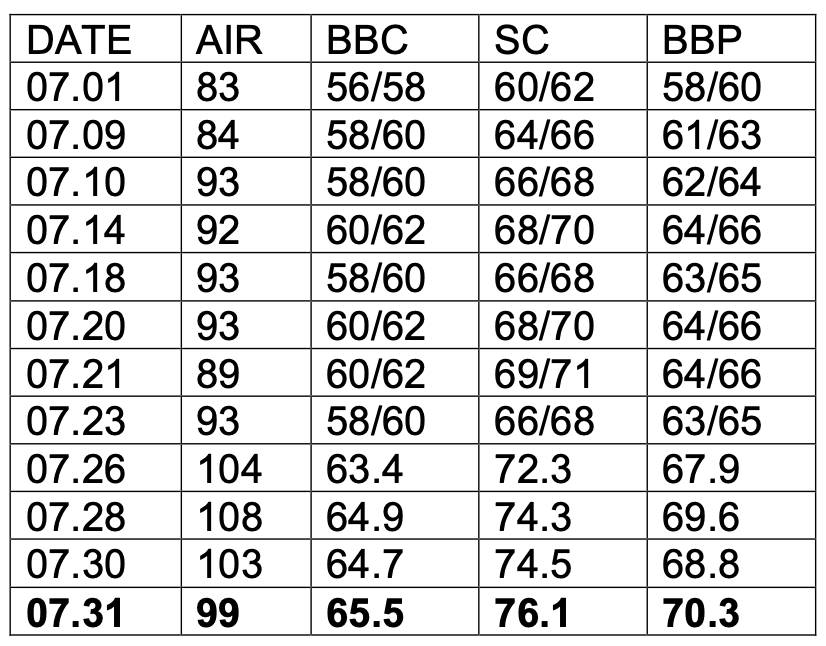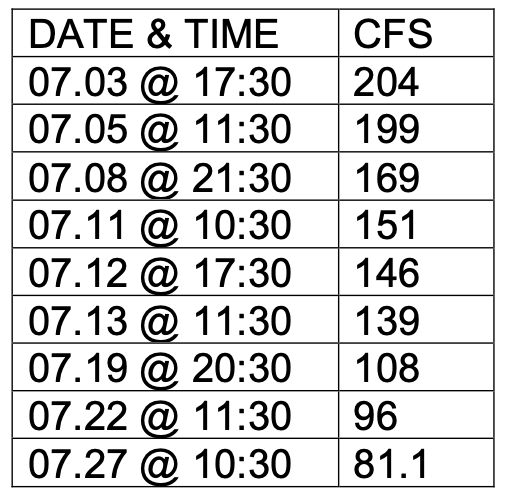FISHWATCH 2022 MONTHLY REPORT
July 2022
by Edward Kikumoto
COVID19 STATUS – The Big Bend Pool is open to the public this year until further notice to the contrary.
Compliance with CDC guidelines are recommended, especially for those who are unvaccinated and have underlying health concerns.
The FishWatch Caretaker is “social distancing,” and is happy to speak with you…just at a distance.
THE FISHWATCH MISSION
1) Deter poaching of the steelhead in the Big Bend Pool.
2) Keep human disturbance of the steelhead in the Pool to a minimum.
3) Educate the public about the Pool and its wild summer steelhead.
DISCLAIMER
The opinions in this report are strictly my own, and do not reflect the views and opinions of the U.S. Forest Service (USFS), the Oregon Department of Fish & Wildlife (ODFW), or The North Umpqua Foundation (TNUF).
Greetings from the Big Bend Pool,
OVERVIEW
I have not observed any illegal, unlawful or unacceptable behavior at the Pool during this period.
There were 166 visitors to the Pool on the 17 days I was present during daytime at the Pool.
The wild summer steelhead appeared in the Pool for the first time this month. I observed 2 steelhead in the Pool, on July 1st.
On July 8, ODFW divers counted 33 steelhead in Big Bend Pool, and 28 steelhead lower in Steamboat Creek.
On July 27, the ODFW diver counted 104 steelhead in the Pool, with a further 66 steelhead downstream. The diver also observed two Chinook downstream, and a Jack Chinook in the Big Bend Pool.
Reports from fishers on the North Umpqua River are that steelhead have been observed moving upstream in numbers (more than one at a time).
The easiest way to distinguish a Chinook from a steelhead is to look at their tails. Chinook have a forked tail, and steelhead have square tails. That is to say the back edge of the tail of the steelhead is straight (I>—-), whereas the Chinook tail’s back edge is V-shaped (>—-). The markings on their sides and the color of the inside of the mouth are different as well but harder to discern from a distance.
Higher than recent historical normal water levels (10-years of drought conditions), and weather conditions seem to have changed the patterns that we have become accustomed too for this time of year.
Higher than normal water flows continued from May into July, along with cooler water temperatures, although a late July heat wave has raised water temperatures.
Mid-summer water levels, steelhead counts, and environmental conditions, all seem to have been delayed a full month.
ODFW is expected to issue a news report in early August, on the status of the North Umpqua River’s wild summer steelhead return.
THEY’RE BACK! THANK GOODNESS!
We were worried that last year’s low return was going to be the beginning of a trend, and that something was going on in the ocean that was killing steelhead, and possibly more than one generation. The steelhead made a late start, but they are now here and in fairly large numbers. Still not as many as I would like to see but getting closer, and maybe it’s just part of that late trend we have been seeing this summer.
Water levels are finally dropping down to summer low flows, and water temperatures in the Pool remain reasonably cool, except for a spike caused by a heat wave in late July that extended into August (as I write this report). The heat wave caused a water temperature spike of approximately 3 degrees F.
A late July heat wave started on July 26 and continued to July 31 when the temperature dropped slightly to 99oF. Beginning on July 26, the temperature exceeded 100oF, reaching 108oF on July 28 (104oF inside the Airstream). The heat wave raised the water temperature. (See Water Temperature Readings, below.) The steelhead reacted to the higher water temperatures of Big Bend Creek by moving to the very head of the Pool (the dropoff), and nosing into the cooler water flowing out of Big Bend Creek. In mid-afternoon the lead steelhead would nose onto the gravel shelf above the Pool into water less than two-feet deep. This is an incredibly exposed position for the steelhead to be in.
WILDLIFE
The otter and her pups are gone.
Only one beaver remains and I only see it sporadically at dusk. Osprey and a juvenile bald eagle make an occasional appearance.
On my way to the Pool in the late evening (10 PM), I’ve seen blacktail deer (normal), foxes and a skunk (striped from head to tail) – not so normal.
There are also ring-tailed and spotted skunks, though rare.
I’ve also “discovered,” from visitors to the Pool much more knowledgeable than I, that I have a couple of small huckleberry bushes (shrubs) and a number of blueberry bushes (Vaccinium, 2 varieties) at the Pool. The huckleberries had a few flowers and no berries, and the blueberries had berries in some abundance, although small. The Pool is at a relatively low elevation (1,654′), so I was surprised at the huckleberries, since I was always told that I had to go up to the ridgeline to find them in abundance. I’ve also noticed that the blackberries on the North Umpqua River are beginning to ripen.
INFRASTRUCTURE
Up to now I have been using non-ethanol gas in the Honda EU2200i generator. It is always a concern transporting and storing open containers of gas, and non-ethanol gas is more expensive than the ethanol gas used in cars. I have had multi-fuel conversion kits on both of my own Honda generators for some years now that allow them to run on propane, which is cleaner in use (stores in a tank), and in consumption (burns cleaner), and is cheaper than non-ethanol gas. And I no longer have to deal with refilling my generators from open containers of gas. There’s also the added benefit of not having to deal with stale gas in the fuel system if the generator isn’t being used for a long period of time.
I converted the TNUF generator to run on propane or natural gas, as well as gas, and am now running it off of 20-pound propane tanks. I’m now thinking about running a propane line off of the Airstream, which is connected to the 250-gallon AmeriGas propane tank. It would be much more efficient than having to get refills of the 20-pound tanks in town every week or so.
I’ve managed to jury rig a solution to the refrigerator’s warm lower unit (frig) during heat-waves. When the air temperatures are in the 90s or higher, the frig lower unit can’t cool down much below 50oF, and in air temperatures in the 100s it gets as warm as 55oF. Curiously enough the freezer manages to stay under 32oF. This type of refrigerator was never intended for (1) long term use, and (2) desert conditions. My solution is to use the freezer to freeze “blue” ice containers, and put the frozen containers in the lower unit to help keep it cooler. By cycling blue-ice containers between the freezer and frig over a 24-hour period, I can manage to “weather” the heat waves. Daytime temperatures in the 80s, and nighttime temperatures in the 50s allows the refrigerator to cool normally.
The portable toilets have had moderate use this month. The dispersed campsites upstream of the Big Bend Pool are in regular use through the week so there is a significant amount of daytime traffic past the Pool. But what seems to be the case is that there is less day use traffic in the Basin than in the past. It may be because the water temperature in Steamboat Creek has been in the 60s through most of July (another effect of this year’s wet Spring), and only reached the 70s during the last week of July during the heat wave. But I also think that high gas prices at the pump are making the long drive from Roseburg just for the day too costly.
Water temperature readings:
High air (AIR) temperature is around 1PM.
Water temperature taken at dusk (at the moment, around 8PM).
The Big Bend Creek (BBC) water temperature is taken just above its confluence with Steamboat Creek.
The Steamboat Creek (SC) temperature is taken above Big Bend Creek.
The Big Bend Pool (BBP) water temperature is taken at the bottom of the Pool where it flows out mixed (Steamboat Creek and Big Bend Creek).
Keep in mind that the water flowing through the Pool is striated both vertically and horizontally (the water from Steamboat Creek and Big Bend Creek don’t completely mix until they get to the back of the Pool), so that the steelhead find the coldest water flows to hold in.
The two temperature readings (00/00) are from two fisherman’s thermometers.
The later single number with a decimal factor (00.0) is from a ThermoWorks ThermaCheck Plus digital thermometer (much more accurate).
The warmest water temperatures were recorded on July 31st after 3-days of 100oF daytime highs.

USGS Water Flow Gauge at Canton Creek Campground
(Canton Creek & Steamboat Creek combined flow, Cubic Feet Per Second [CFS])

BIG BEND POOL FIELD NOTES
So, what’s going on with the wild summer steelhead this year? Let me do a little speculating based on the unusual weather conditions this year; namely, a wet spring, which we haven’t seen in ten-years of drought.
Drought conditions
Normal for drought conditions is low water from winter into spring with very little, if any, spring runoff. The steelhead are in the Big Bend Pool as early as the first week of May, because they can get over Little Falls, which they could not do if the flows over the falls are too high. (See my Field Notes in the June report.)
Not all the steelhead moving into the Pool this early necessarily stay in the Pool. The water temperatures in the spring are cold (40s & 50s Fahrenheit) even though the water level may be low, so the steelhead are getting enough oxygen, and may go further upstream. When the water temperatures exceed their comfort zone later in the summer (70s F), these steelhead will drop back to the Pool, and its colder water temperatures.
In drought conditions because of the low water flow (for spring) and no spring runoff, the water temperatures are going to get warmer earlier, which will force the steelhead in other parts of Steamboat Creek to seek thermal sanctuary in the Big Bend Pool.
Do the steelhead sense that because of the low water during drought or warmer water temperatures, they need to get to the Pool earlier than later? It appears that the wild summer steelhead that come to the Pool are doing so intentionally, or somehow know that the Big Bend Pool is a thermal sanctuary during summer high water temperatures that make most of Steamboat Creek difficult to survive in, due to a lack of oxygen in the warmer water. The Big Bend Pool is not where these steelhead spawn. They mostly spawn in the tributaries further upstream, which is where they were born, and where their “babies” will be born and also return as adults to spawn. And yet, as adults returning from the ocean, they somehow know that they need to stop in the Big Bend Pool for the summer in order to survive.
Spring!
No one I know remembers what’s suppose to happen if we have a wet Spring. What I hear, from knowledgeable people, is that everything is pushed back a month from what we have become use to – drought conditions. For example, the huckleberries that should be ripening right now are at least a couple of weeks late.
There is still snow up at Crater Lake; and the North Umpqua River is still in spring runoff with water temperatures in the 50s at higher elevations, and in the mid-60s below Steamboat in the flyfishing water. Which is to say that the wild summer steelhead destined for the Big Bend Pool have no environmental reasons to seek the cold water of the Pool. In addition, the high spring flows over Little Falls may have blocked the early steelhead from getting over it, until the flow over the Falls began to drop in late June. (See my Field Notes in my June report.) So the steelhead are just late to the Pool. Rumor has it that pods of steelhead have been seen moving upstream in the lower river. With the flows in Steamboat Creek beginning to reach its summer low, these steelhead may stay in the North Umpqua given the ideal water conditions, and/or wait until the higher and cooler flows of Fall to make their migration up to the Big Bend Pool and beyond.
Because of the continued spring runoff in the North Umpqua and subsequent ideal water temperatures, the steelhead are not bunching up in the historic Camp Water (at the confluence of the North Umpqua River and Steamboat Creek) as they normally do under drought conditions. The steelhead are spread out throughout the flyfishing water.
Numbers
On July 27, the ODFW diver counted 104 steelhead in the Big Bend Pool, and an additional 66 steelhead downstream, for an aggregated total of 170 steelhead.
The assumption being made here is that the steelhead downstream will eventually move into the Pool, which is what has happened in the past. However, this wet spring is extraordinary, so they may just stay there.
Historically 60 to 70 percent of the total of wild summer steelhead crossing Winchester Dam for the year cross it in June and July. So we don’t know how many more steelhead will be moving into Steamboat Creek from the July numbers across Winchester Dam. And given how everything seems to be late, I may see a surge of steelhead into the Pool in August. We can only hope.
If the 170 steelhead counted is the total for the year, then it will be the lower end of the annual return numbers we have seen in recent years. Nevertheless, the fact that this many steelhead have returned makes last year’s 55 steelhead in the Pool, an anomaly caused, most likely, by the 2021 June heat wave that blocked, if not outright killed most of the wild summer steelhead that were trapped by the thermal barriers (temperatures in the 70s and 80s) at Winchester Dam and below it. The total annual return of wild summer steelhead last year was 450 steelhead, normal being in excess of 1,400 steelhead.
Some speculative thinking…
55 steelhead out of 450 steelhead is 12%.
If 170 steelhead is 12%, then we’re looking at about 1,400 steelhead as the total annual return this year, which is low normal.
END OF JULY 2022 REPORT
Respectfully submitted,
Ed Kikumoto
FishWatch 2022 Caretaker
